Physical Address
304 North Cardinal St.
Dorchester Center, MA 02124
Blepharoplasty is a vital part of facial rejuvenation. The traditional removal of tissue may or may not be the preferred approach when assessed in relation to modern cosmetic goals.
A thorough understanding of orbital and eyelid anatomy is necessary to understand aging in the periorbital region and to devise appropriate surgical strategies.
Preoperative assessment includes a review of the patient's perceptions, assessment of the patient's anatomy, and an appropriate medical and ophthalmologic examination.
Surgical techniques in blepharoplasty are numerous and should be tailored to the patient's own unique anatomy and aesthetic diagnosis.
Interrelated anatomic structures including the brow and the infraorbital rim may need to be surgically addressed for an optimal outcome.
Access video and video lecture content for this chapter online at Elsevier eBooks+ ![]()
![]()
Properly performed aesthetic periorbital surgery is one of the most rejuvenating of all facial surgeries performed today. Properly conceived and executed, it proves a tremendous source of joy for both surgeon and patient. Done poorly, it can lead to a lifetime of disfigurement and functional problems for the patient, sleepless nights for the surgeon, and dissatisfaction for both participants. The problem is magnified because aesthetic periorbital surgical procedures are among the most commonly performed in plastic surgery practices.
Traditional methods of aesthetic periorbital surgery often produce suboptimal results. A departure from the standard techniques of the past is recommended. Most plastic surgeons know there is a better way, and those who persist with traditional techniques may soon be deviating from a new standard of surgical care. It is this new standard that is advocated in this chapter. When they are understood and adopted, these new standards eliminate the classic complications and risks associated with traditional techniques.
Instead of the common practice of excising precious upper and, to a somewhat lesser degree, lower eyelid tissue, it is preferable to focus on restoration of attractive, youthful anatomy. To expect that the simple removal of tissue will always result in beautiful or youthful eyes is unrealistic, because this may not fully correct the aging eye deformity.
One should first conceptualize the desired outcome, then select and execute procedures accurately designed to achieve those specific goals. For this task to be accomplished, several important principles are advocated ( Box 13.1 ). Enthusiastically embraced, this approach is likely to result in excellent aesthetic quality of surgical outcomes.
Control of periorbital aesthetics by proper brow positioning, corrugator muscle removal, and lid fold invagination when beneficial.
Restoration of tone and position of the lateral canthus and, along with it, restoration of a youthful and attractive intercanthal axis tilt.
Restoration of the tone and posture of the lower lids.
Preservation of maximal lid skin and muscle (so essential to lid function and aesthetics) as well as orbital fat.
Lifting of the midface through reinforced canthopexy, preferably enhanced by composite malar advancement.
Correction of suborbital malar grooves with tear trough (or suborbital malar) implants, obliterating the deforming tear trough (bony) depressions that angle down diagonally across the cheek, which begin below the inner canthus.
Control of orbital fat by septal restraint or quantity reduction.
Removal of only that tissue (skin, muscle, fat) that is truly excessive on the upper and lower lids, sometimes resorting to unconventional excision patterns.
Modification of skin to remove prominent wrinkling and excision of small growths and blemishes.
It is an absolute necessity that the surgeon understands the essential and dynamic periorbital anatomy to effect superior aesthetic and functional surgical results. No surgeon should perform surgery without fully understanding the aesthetic and functional consequences of the choices.
The orbits are pyramids formed by the frontal, sphenoid, maxillary, zygomatic, lacrimal, palatine, and ethmoid bones ( Fig. 13.1 ). The periosteal covering, or periorbita, is most firmly attached at the suture lines and the circumferential anterior orbital rim. The investing orbital septum, in turn, attaches to the periorbita of the orbital rim, forming a thickened perimeter known as the arcus marginalis. This structure reduces the perimeter and diameter of the orbital aperture and is thickest in the superior and lateral aspects of the orbital rim.
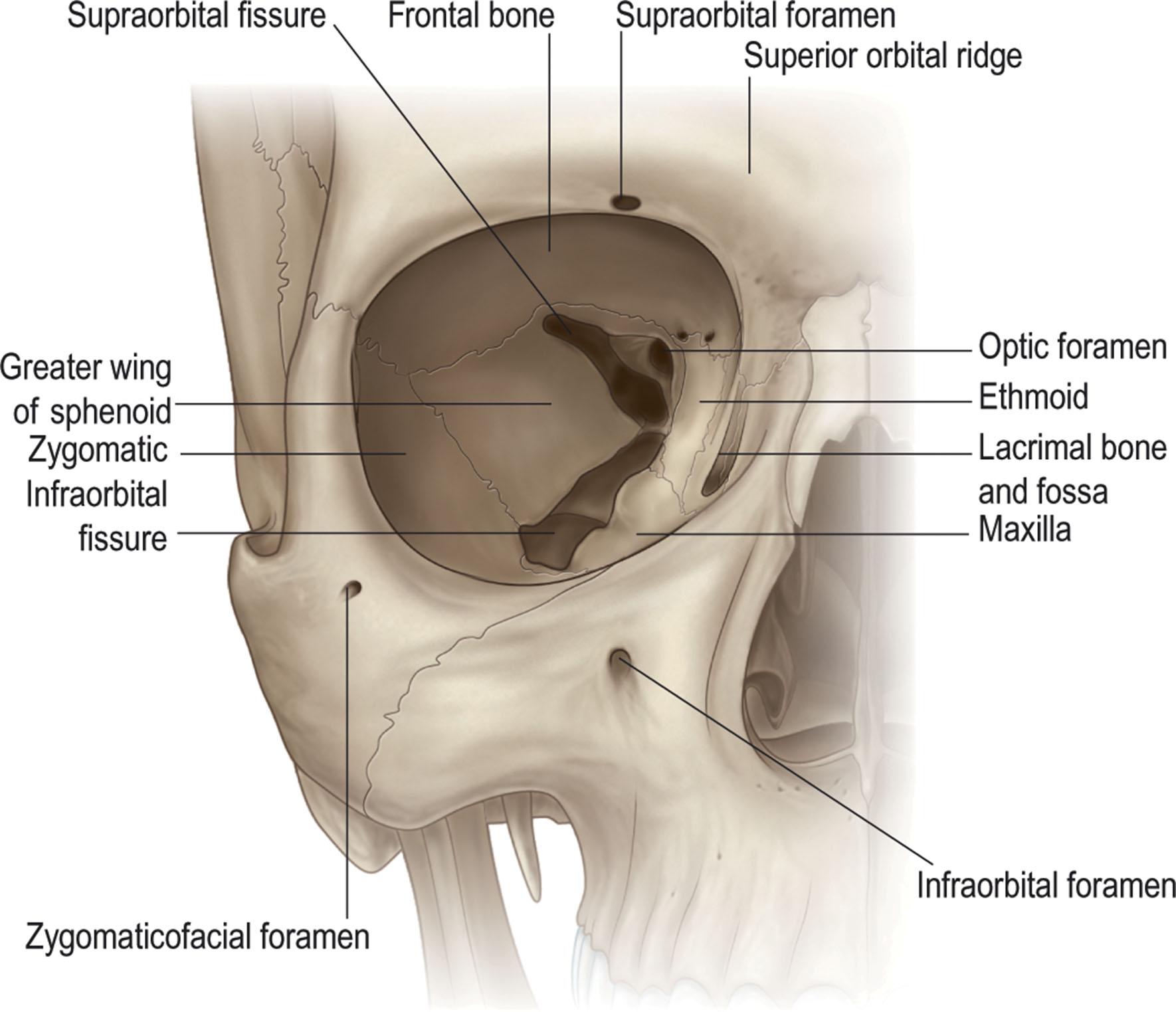
Certain structures must be avoided during upper lid surgery. The lacrimal gland, located in the superolateral orbit deep to its anterior rim, often descends beneath the orbital rim, prolapsing into the postseptal upper lid in many persons. During surgery, the gland can be confused with the lateral extension of the central fat pad destined for removal during aesthetic blepharoplasty. The trochlea is located 5 mm posterior to the superonasal orbital rim and is attached to the periorbita. Disruption of this structure can cause motility problems.
As far back as the tenth and eleventh centuries, Arabian surgeons Avicenna and Ibn Rashid described the significance of excess skin folds in impairing eyesight. Even at an early date, surgeons had excised upper eyelid skin to improve vision. Texts published in the eighteenth and nineteenth centuries were the first to describe and illustrate the upper eyelid aging deformities. The term “blepharoplasty” was coined by Von Graefe in 1818 to describe reconstructive procedures employed following oncologic excisions. Several European surgeons developed reconstructive techniques for eyelid defects in the latter half of the nineteenth century. Graefe and Mackenzie would be credited with applying these reconstructive principles and publishing the first, reproducible cases of upper blepharoplasty. The concepts of herniated orbital fat pads were described shortly thereafter by Sichel and Bourguet, respectively. Orbital fat pads were originally considered to be “circumscribed tumors” of fat that made movement of the upper lid more difficult. It was a rare condition found “most often in children”. Cosmetic blepharoplasty entered a period of rapid growth and research in the 1920s and 1930s. Contributions were made that described nearly 13 different approaches and closure methods. Recent variations in technique appear to have a basis in these early techniques, which have cycled in popularity over the past decade.
Anchored to the lateral orbit is a labyrinth of connective tissues that are crucial to maintenance of the integrity, position, and function of the globe and periorbital. Understanding how to effectively restore these structures is key to periocular rejuvenation by canthopexy. These structures, known as the lateral retinaculum, coalesce at the lateral orbit and support the globe and eyelids like a hammock ( Fig. 13.2 ). The lateral retinaculum consists of the lateral canthal tendon, tarsal strap, lateral horn of the levator aponeurosis, the Lockwood suspensory ligament, Whitnall's ligament, and check ligaments of the lateral rectus muscle. They converge and insert securely into the thickened periosteum overlying Whitnall's tubercle. Controversy exists surrounding the naming of the components of the lateral canthal tendon. Recent cadaveric dissections suggest that the lateral canthal tendon has dual insertions. A superficial component is continuous with the orbicularis oculi fascia and attaches to the lateral orbital rim and deep temporal fascia by means of the lateral orbital thickening. A deep component that connects directly to Whitnall's tubercle is classically known as the lateral canthal tendon ( Fig. 13.3 ).
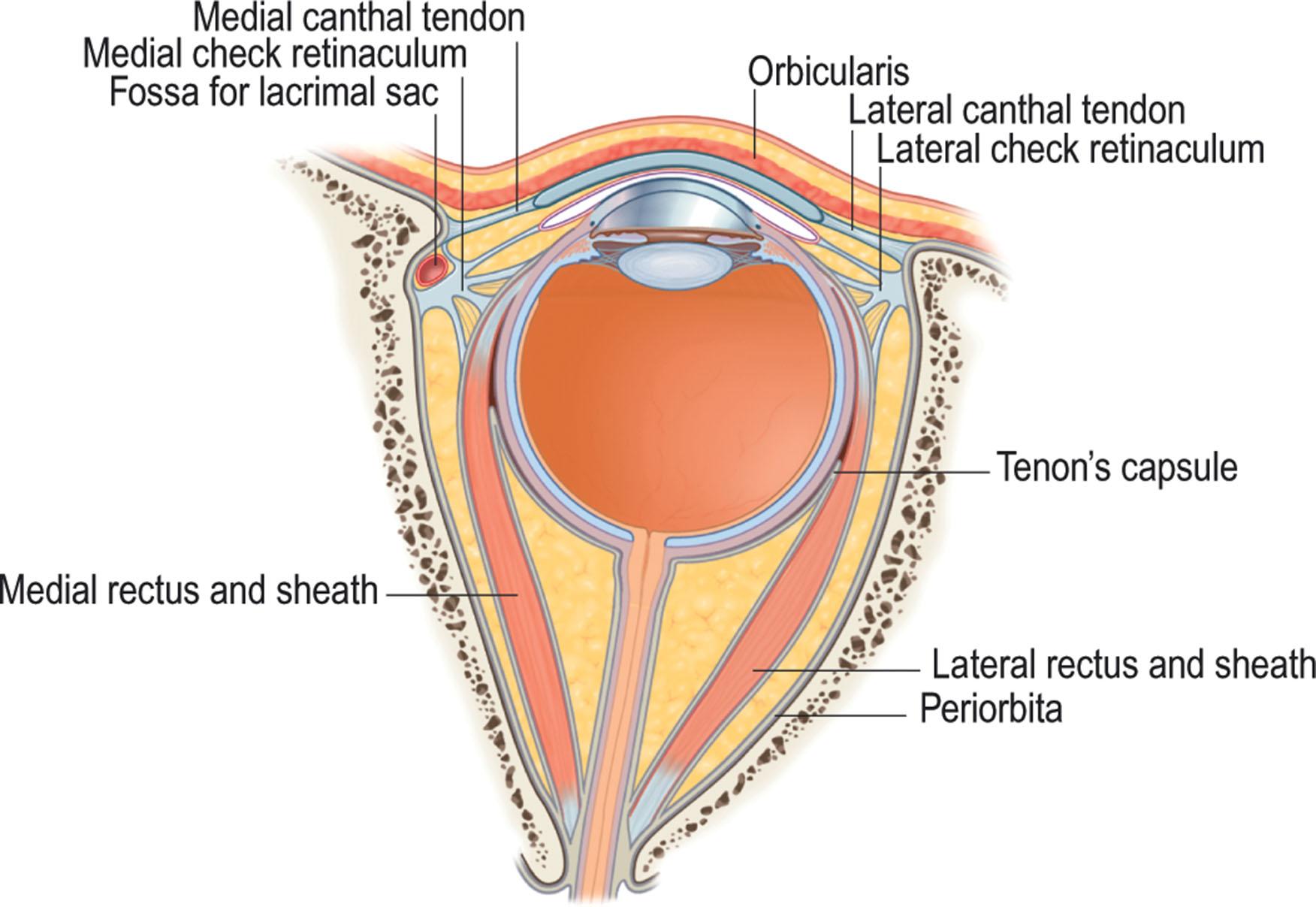
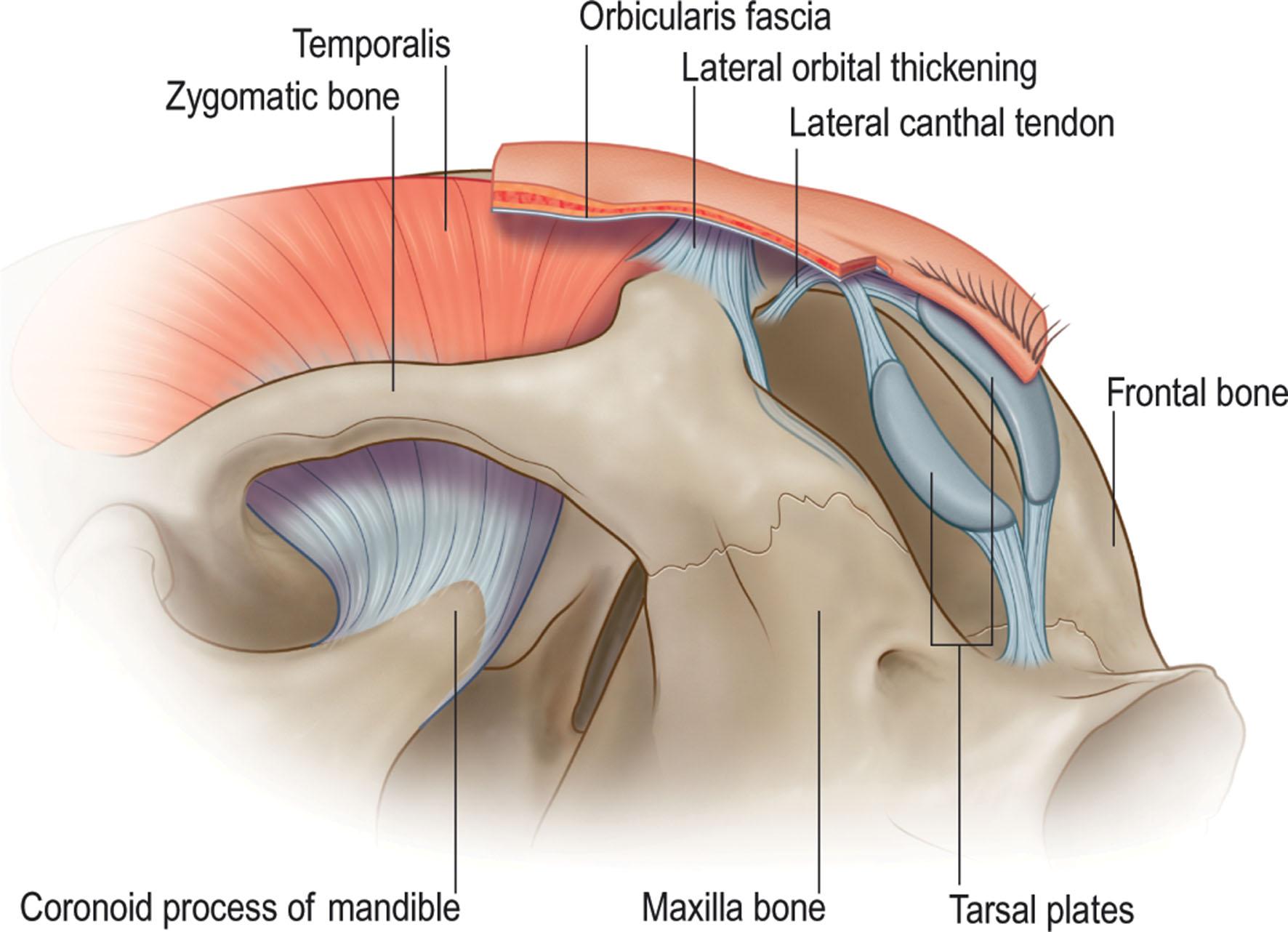
In addition, the tarsal strap is a distinct anatomic structure that inserts into the tarsus medial and inferior to the lateral canthal tendon. In contrast to the canthal tendon, the thick tarsal strap is relatively resistant to laxity changes seen with aging. The tarsal strap attaches approximately 3 mm inferiorly and 1 mm posteriorly to the deep lateral canthal tendon, approximately 4–5 mm from the anterior orbital rim. It shortens in response to lid laxity, benefiting from release during surgery to help achieve a long-lasting restoration or elevation canthopexy ( Fig. 13.4 ). Adequate release of the tarsal strap permits a tension-free canthopexy, minimizing the downward tethering force of this fibrous condensation. This release along with a superior reattachment of the lateral canthal tendon is key to a successful canthopexy.
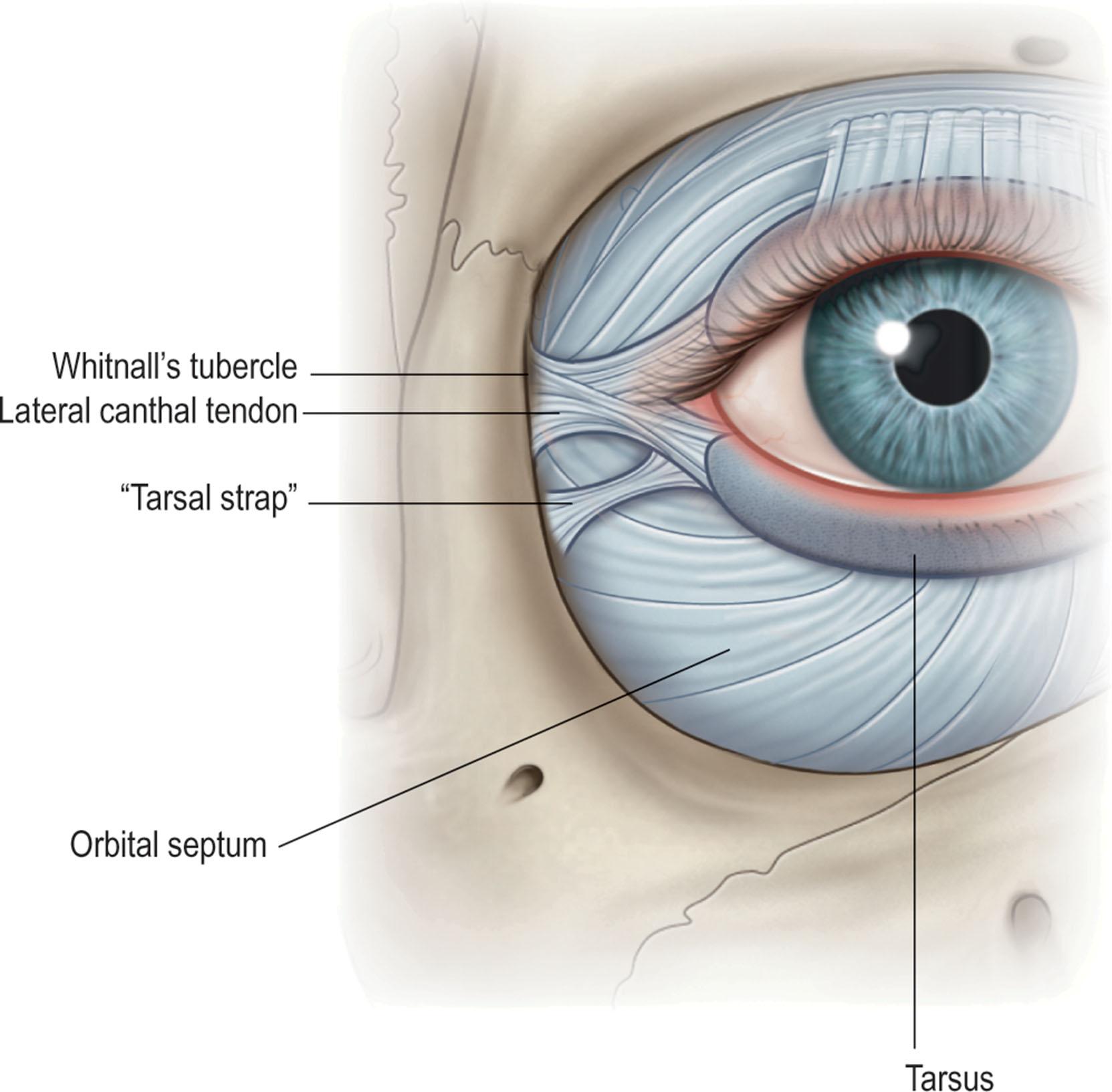
A hammock of fibrous condensations suspends the globe above the orbital floor. The medial components of the apparatus include medial canthal tendon, the Lockwood suspensory ligament, and check ligaments of the medial rectus. The medial canthal tendon, like the lateral canthal tendon, has separate limbs that attach the tarsal plates to the ethmoid and lacrimal bones. Each limb inserts onto the periorbital of the apex of the lacrimal fossa. The anterior limb provides the bulk of the medial globe support ( Fig. 13.5 ).
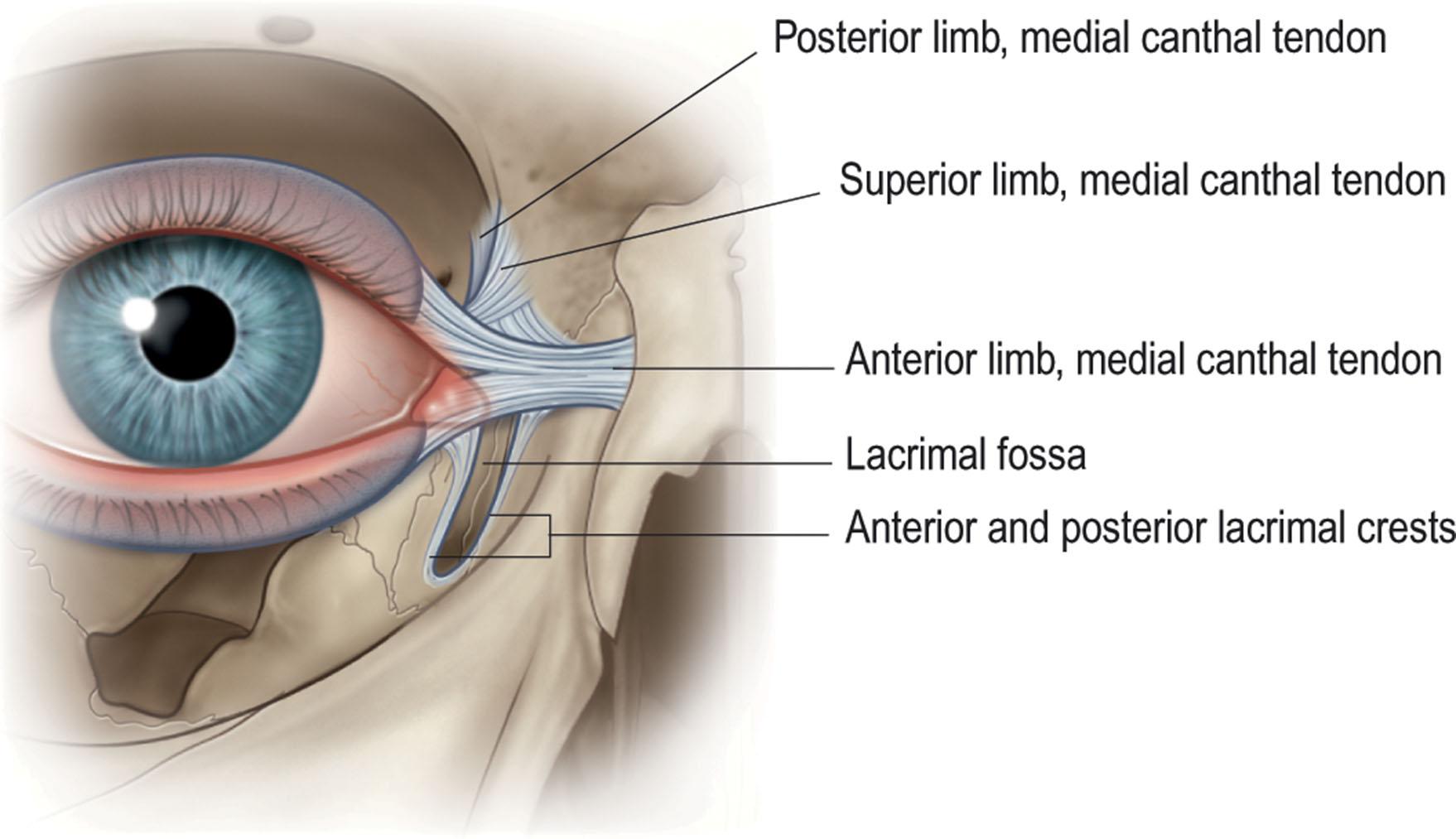
The forehead and brow consist of four layers: skin, subcutaneous tissue, muscle, and galea. There are four distinct brow muscles: frontalis, procerus, corrugator superciliaris, and orbicularis oculi ( Fig. 13.6 ). The frontalis muscle inserts predominately into the medial half or two-thirds of the eyebrow ( Fig. 13.7 ), allowing the lateral brow to drop hopelessly ptotic from aging, while the medial brow responds to frontalis activation and elevates, often excessively, in its drive to clear the lateral overhang. Constant contraction of the frontalis will give the appearance of deep horizontal creases in the forehead ( Fig. 13.8 ).
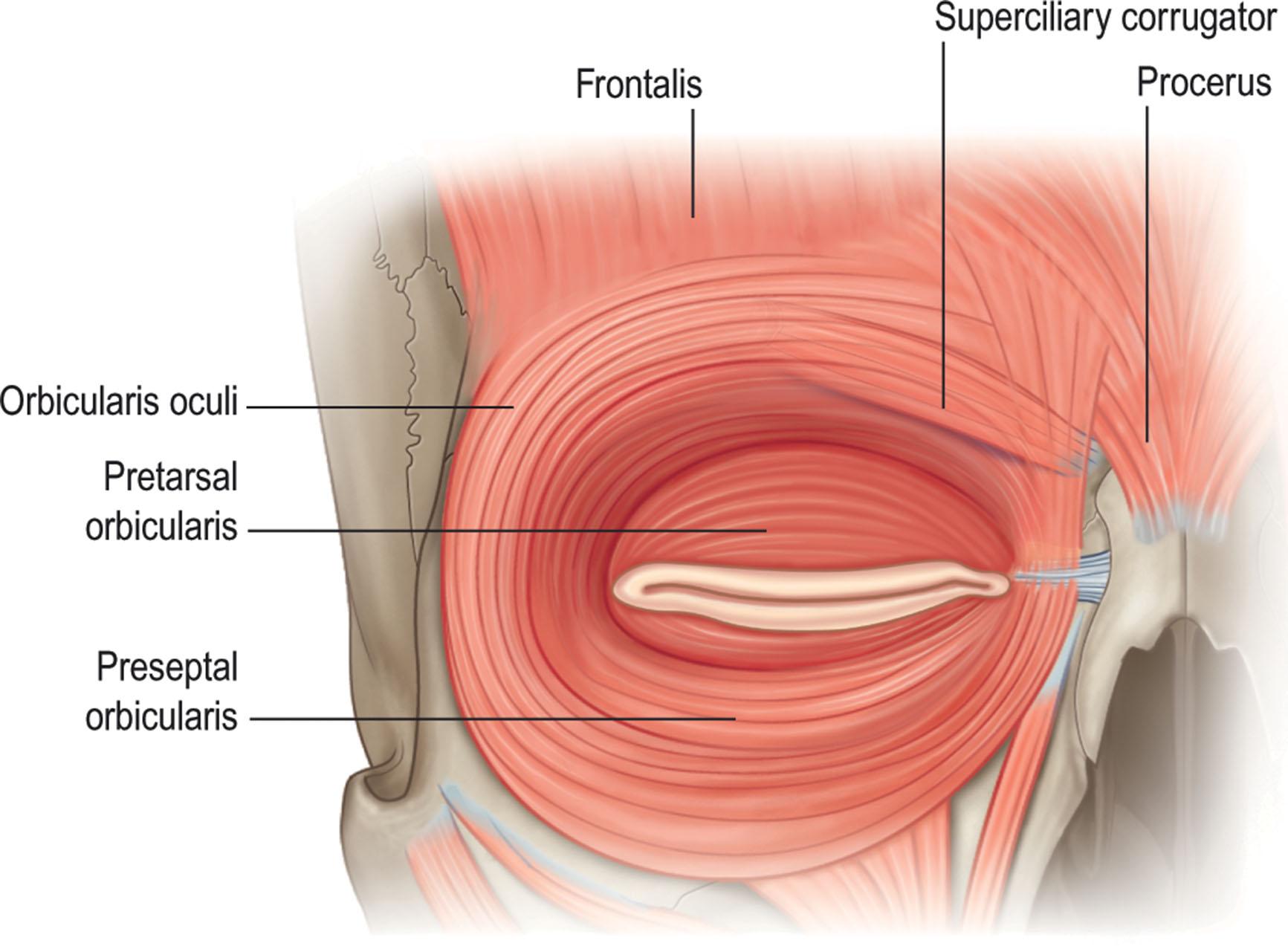
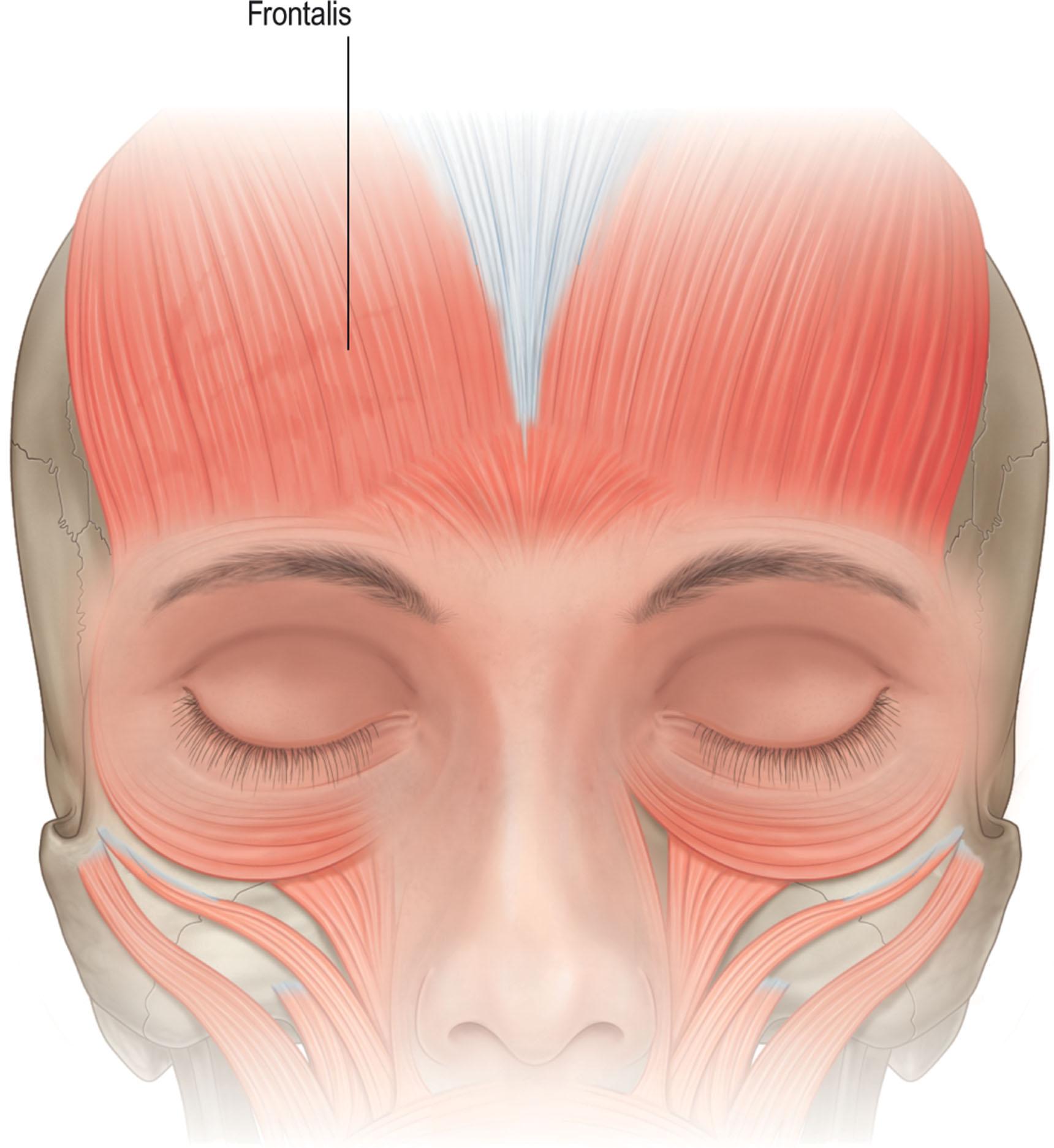
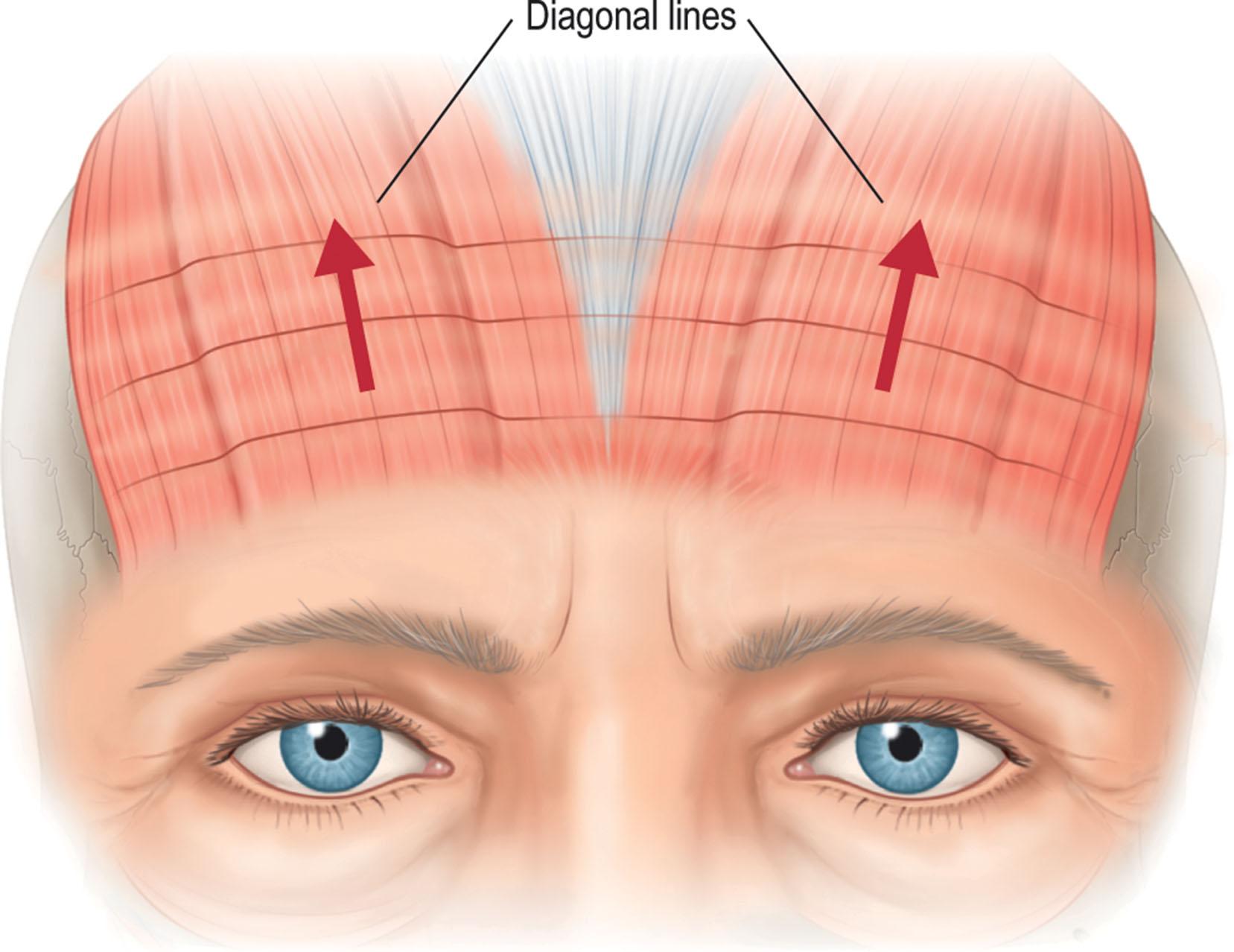
The vertically oriented procerus is a medial muscle, often continuous with the frontalis, arising from the nasal bones and inserting into the subcutaneous tissue of the glabellar region. It pulls the medial brow inferiorly and contributes to the horizontal wrinkles at the root of the nose. More commonly, these wrinkles result from brow ptosis and correct spontaneously with brow elevation.
The obliquely oriented corrugator muscle arises from the frontal bone and inserts into the brow tissue laterally, with some extensions into orbicularis and frontalis musculature, forming vertical glabellar furrows during contraction. Wrinkles from procerus and corrugators contraction can worsen significantly after upper lid tissue excision as a result of the frontalis muscles relaxing after being relieved of the need to clear the obstructing lid skin.
The eyelids are vital, irreplaceable structures that serve to protect the globes. Their shutter-like mechanism is essential to clean, lubricate, and protect the cornea. Any disruption or restriction of eyelid closure will have significant consequences for both the patient and the surgeon.
There is much similarity between upper and lower eyelid anatomy. Each consists of an anterior lamella of skin and orbicularis muscle and a posterior lamella of tarsus and conjunctiva ( Fig. 13.9 ).
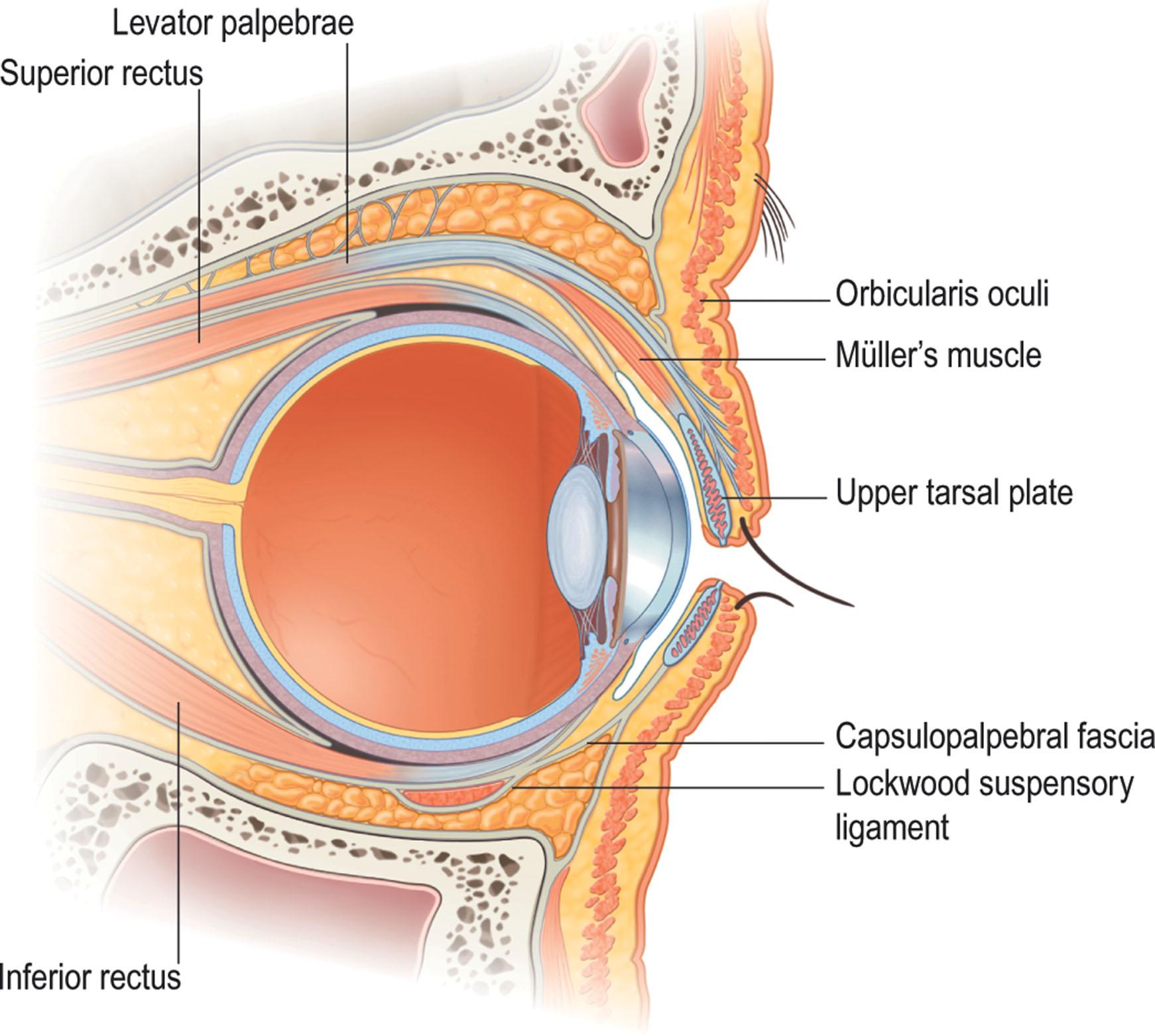
The orbicularis muscle, which acts as a sphincter for the eyelids, consists of orbital, preseptal, and pretarsal segments. The pretarsal muscle segment fuses with the lateral canthal tendon and attaches laterally to Whitnall's tubercle. Medially it forms two heads, which insert into the anterior and posterior lacrimal crests (see Fig. 13.6 ).
The orbital septum originates superiorly at the arcus and forms the anterior border of the orbit. It joins with the levator aponeurosis, just superior to the tarsus. The sling formed by the union of these two structures houses the orbital fat.
The levator palpebrae superioris muscle originates above the annulus of Zinn. It extends anteriorly for 40 mm before becoming a tendinous aponeurosis below Whitnall's ligament. The aponeurosis fans out medially and laterally to attach to the orbital retinacula. The aponeurosis fuses with the orbital septum above the superior border of the tarsus and at the caudal extent of the sling, sending fibrous strands to the dermis to form the lid crease. Extensions of the aponeurosis finally insert into the anterior and inferior tarsus. As the levator aponeurosis undergoes senile attenuation, the lid crease rises into the superior orbit from its remaining dermal attachments while the lid margin drops.
Müller's muscle, or the supratarsal muscle, originates on the deep surface of the levator near the point where the muscle becomes aponeurotic and inserts into the superior tarsus. Dehiscence of the attachment of the levator aponeurosis to the tarsus results in an acquired ptosis only after the Müller's muscle attenuates and loses its integrity.
In the Asian eyelid, fusion of the levator and septum commonly occurs at a lower level, allowing the sling and fat to descend farther into the lid. This lower descent of fat creates the characteristic fullness of their upper eyelid. In addition, the aponeurotic fibers form a weaker attachment to the dermis, resulting in a less distinct lid fold ( Fig. 13.10 ).
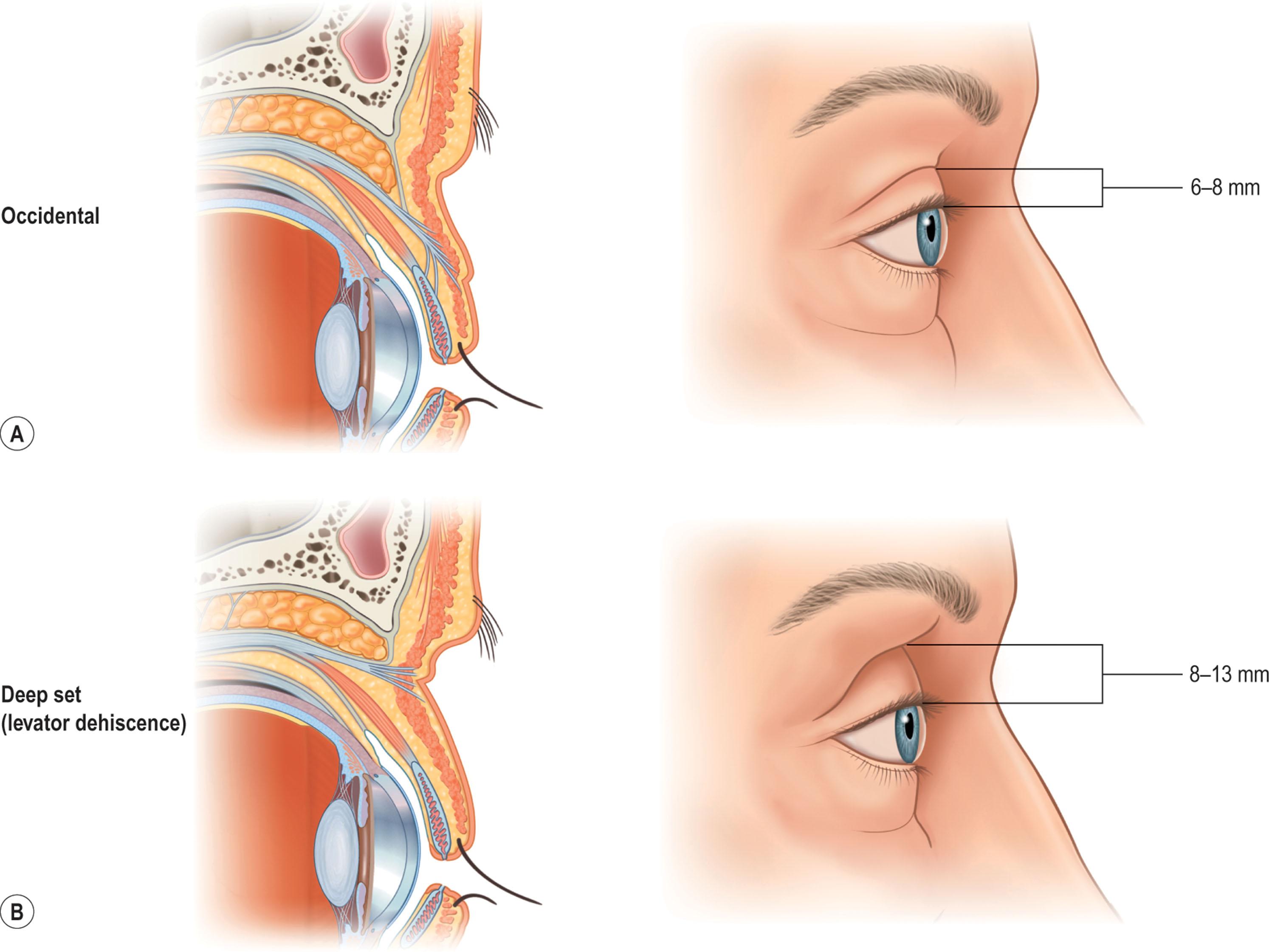
The orbital septum has an adhesion to the levator aponeurosis above the tarsus. The septum continues beyond this adhesion and extends to the ciliary margin. It is superficial to the preaponeurotic fat found at the supratarsal crease. The septal extension is a dynamic component to the motor apparatus, as traction on this fibrous sheet reproducibly alters ciliary margin position ( Fig. 13.11 ). The septal extension serves as an adjunct to, and does not operate independent of, levator function, as mistaking the septal extension for levator apparatus and plicating this layer solely results in failed ptosis correction.
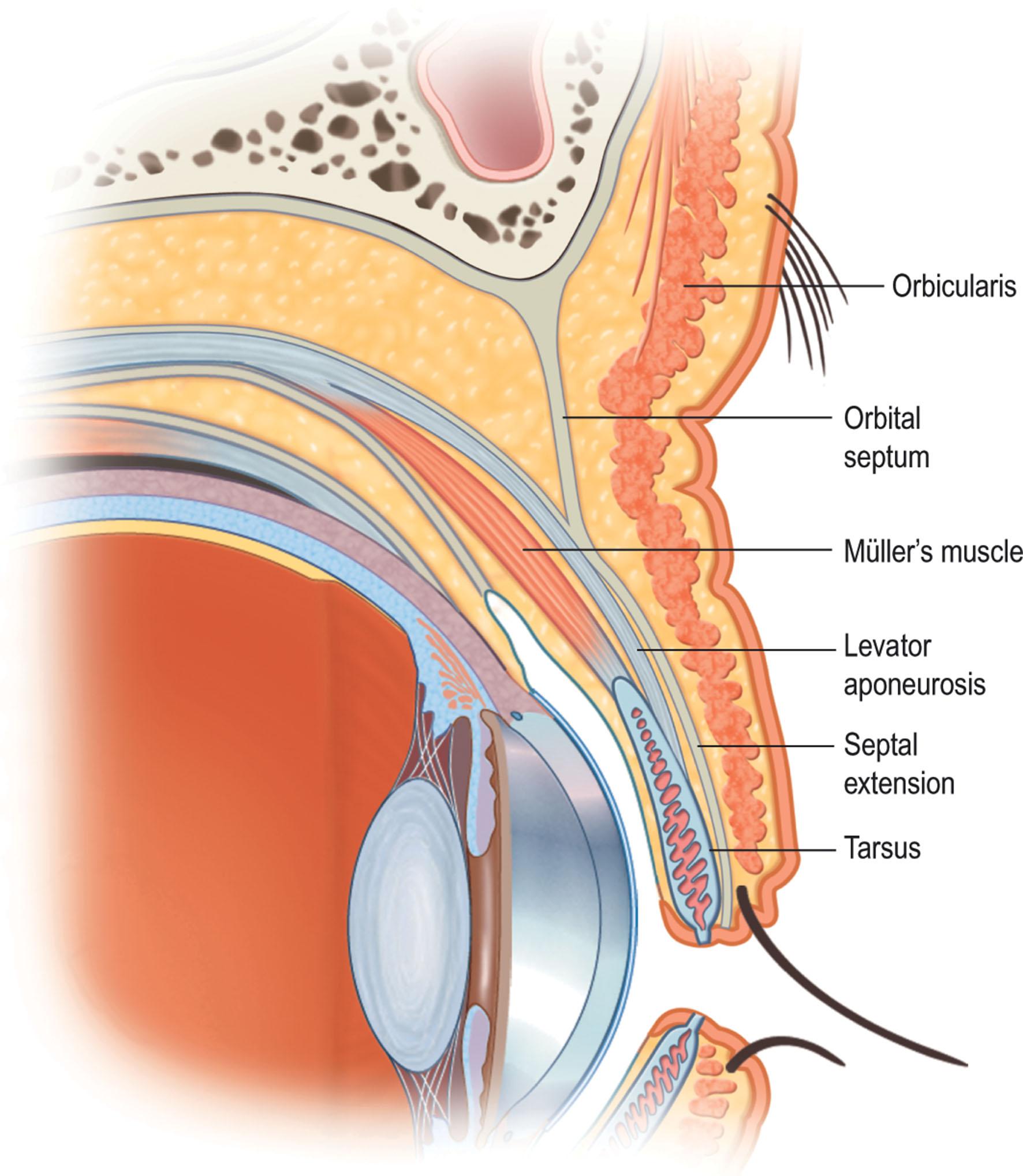
The anatomy of the lower eyelid is somewhat analogous to that of the upper eyelid. The retractors of the lower lid, the capsulopalpebral fascia, correspond to the levator above. The capsulopalpebral head splits to surround and fuse with the sheath of the inferior oblique muscle. The two heads fuse to form the Lockwood suspensory ligament, which is analogous to Whitnall's ligament. The capsulopalpebral fascia fuses with the orbital septum 5 mm below the tarsal border and then inserts into the anterior and inferior surface of the tarsus. The inferior tarsal muscle is analogous to Müller's muscle of the upper eyelid and also arises from the sheath of the inferior rectus muscle. It runs anteriorly above the inferior oblique muscle and also attaches to the inferior tarsal border.
The combination of the orbital septum, orbicularis, and skin of the lower lid acts as the anterior barrier of the orbital fat. As these connective tissue properties relax, the orbital fat is allowed to herniate forward, forming an unpleasing, full lower eyelid. This relative loss of orbital volume leads to a commensurate, progressive hollowing of the upper lid as upper eyelid fat recesses.
The capsulopalpebral fascia and its overlying conjunctiva form the posterior border of the lower orbital fat. Transection of the capsulopalpebral fascia during lower lid procedures, particularly transconjunctival blepharoplasty, releases the retractors of the lower eyelid, which can reduce downward traction and allow the position of the lower lid margin to rise.
A network of ligaments serves as a scaffold for the skin and subcutaneous tissue surrounding the orbit. The orbital retaining ligament directly attaches the orbicularis at the junction of its orbital and preseptal components to the periosteum of the orbital rim and, consequently, separates the prezygomatic space from the preseptal space. This ligament is continuous with the lateral orbital thickening, which inserts onto the lateral orbital rim and deep temporal fascia. It also has attachments to the superficial lateral canthal tendon (see Fig. 13.3; Figs. 13.12 & 13.13 ). Attenuation of these ligaments permits descent of orbital fat onto the cheek. A midfacelift must release these ligaments to achieve a supported, lasting lift.
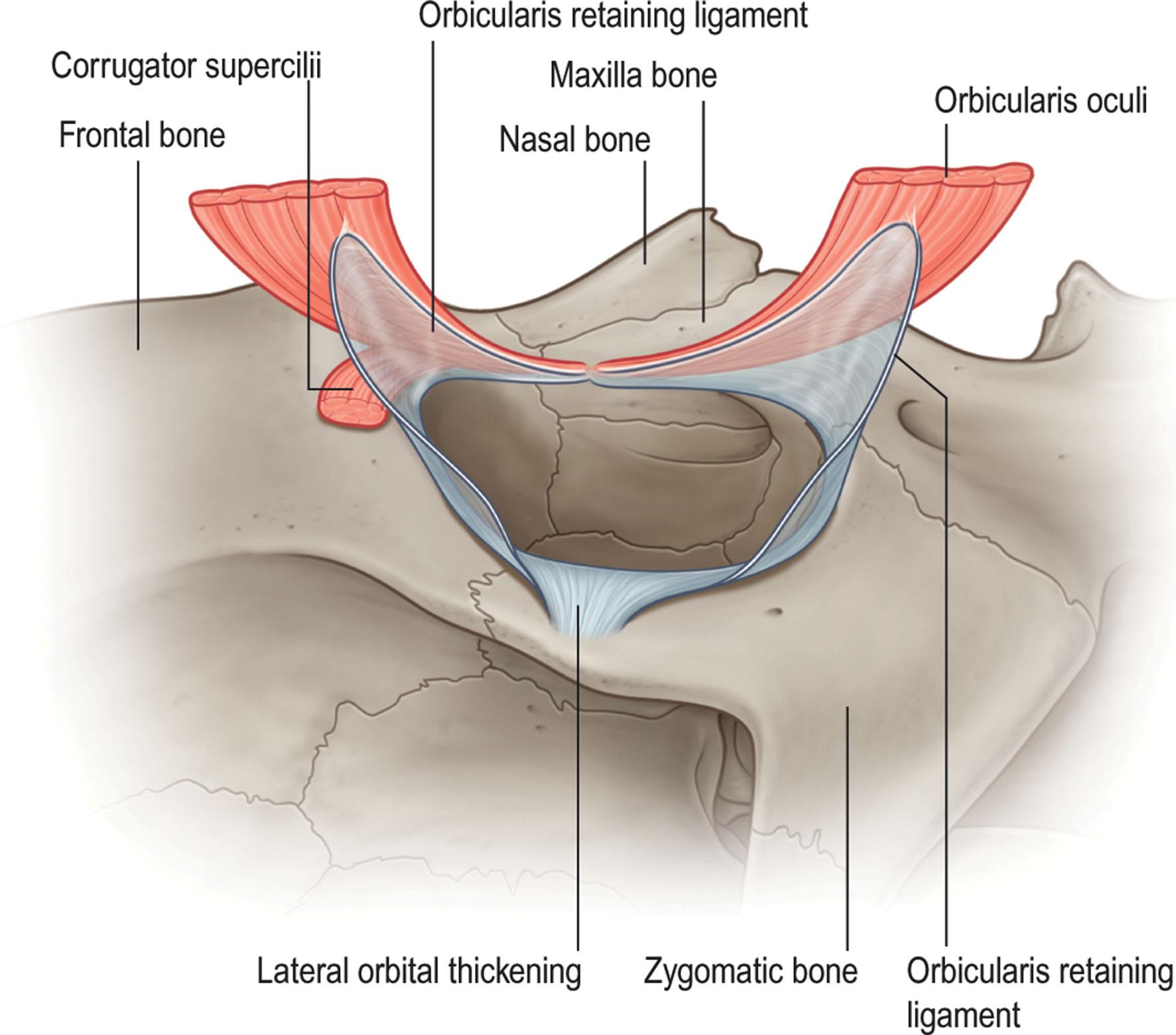
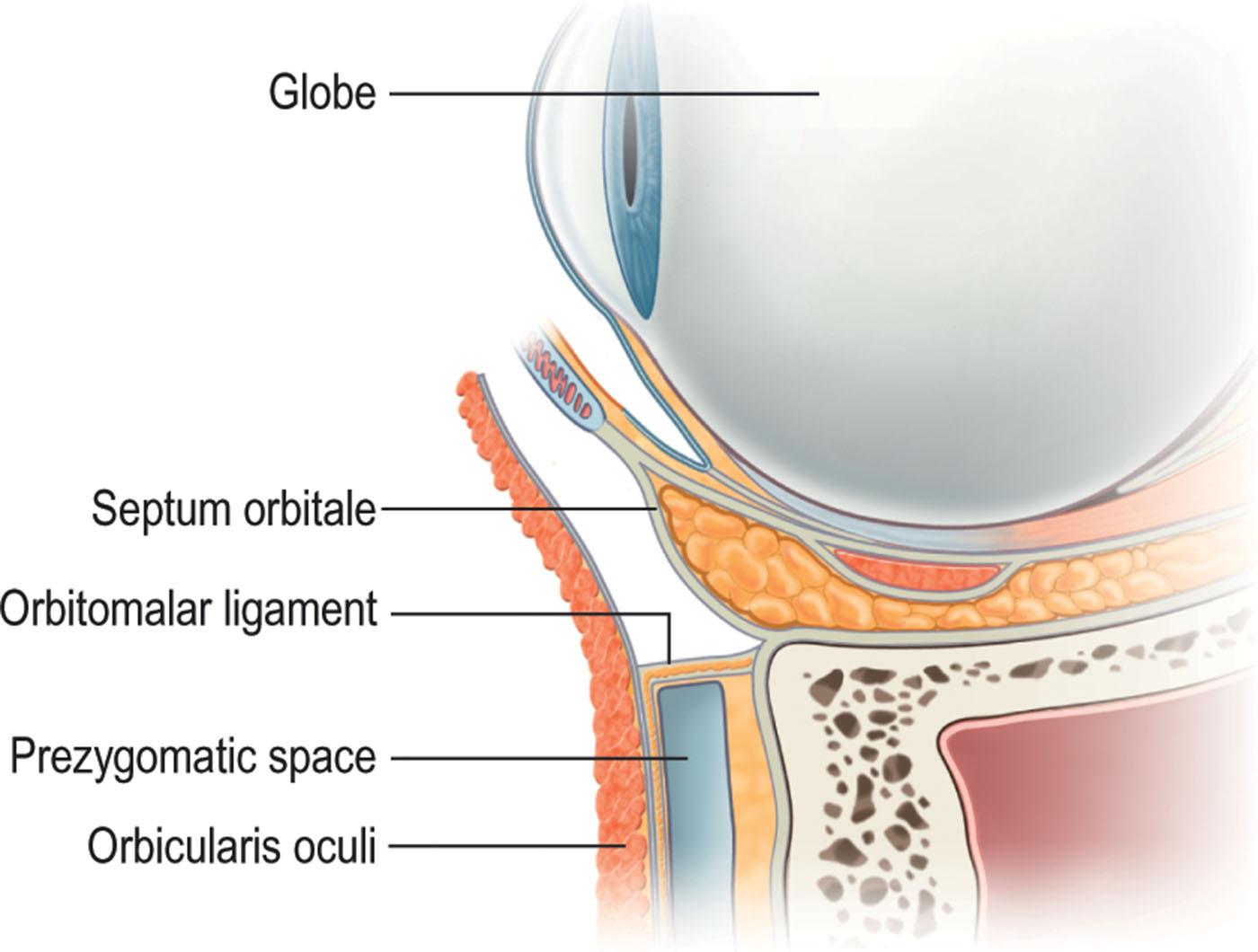
The internal and external carotid arteries supply blood to the orbit and eyelids ( Fig. 13.14 ). The ophthalmic artery is the first intracranial branch of the internal carotid; its branches supply the globe, extraocular muscles, lacrimal gland, ethmoid, upper eyelids, and forehead. The external carotid artery branches into the superficial temporal and maxillary arteries. The infraorbital artery is a continuation of the maxillary artery and exits 8 mm below the inferomedial orbital rim to supply the lower eyelid.
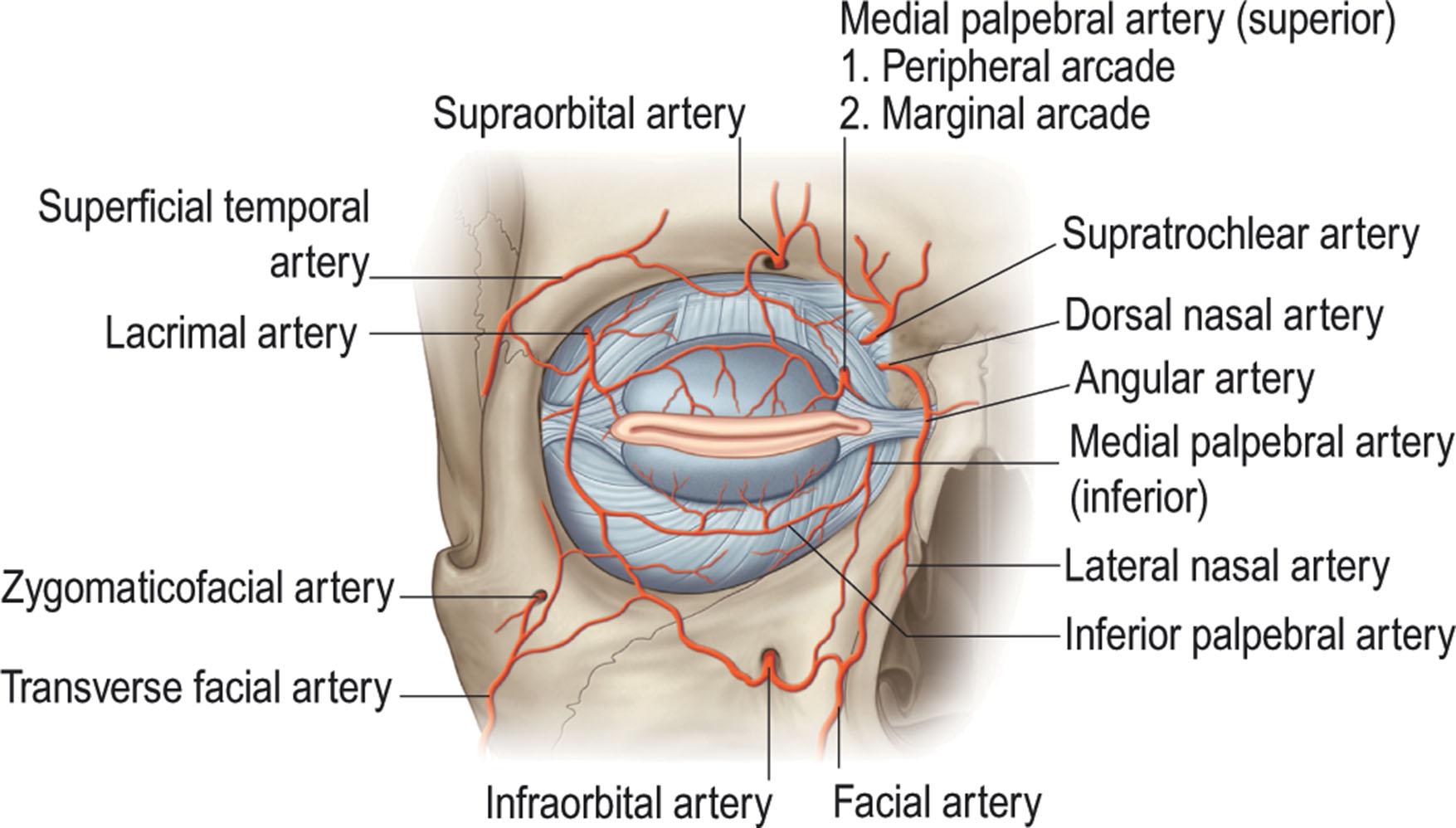
The arcade of the superior and inferior palpebral arteries gives a rich blood supply to the eyelids. The superior palpebral artery consists of a peripheral arcade located at the superior tarsal border – the area where surgical dissection occurs to correct lid ptosis and to define lid folds. Damage to a vessel within this network commonly results in a hematoma of Müller's muscle, causing lid ptosis for 2–8 weeks postoperatively. Likewise, on the lower lid, the inferior palpebral artery lies at the inferior border of the inferior tarsus.
The supratrochlear, dorsal nasal, and medial palpebral arteries all traverse the orbit medially. Severing these arteries during fat removal, without adequately providing hemostasis, may lead to a retrobulbar hematoma, a vision-threatening complication of blepharoplasty.
The trigeminal nerve along with its branches provides sensory innervations to the periorbital region ( Fig. 13.15 ). The ophthalmic division enters the orbit and divides into the frontal, nasociliary, and lacrimal nerves. The terminal branch of the nasociliary nerve, the infratrochlear nerve, supplies the medial conjunctiva, and lacrimal sac. The lacrimal nerve supplies the lateral conjunctiva and skin of the lateral upper eyelid. The frontal nerve, the largest branch, divides into the supraorbital and supratrochlear branches. The supraorbital nerve exits through either a notch or a foramen and provides sensory innervations to the skin and conjunctiva of the upper eyelid and the scalp. The supratrochlear nerve innervates the skin of the glabella, forehead, medial upper eyelid, and medial conjunctiva. A well-placed supraorbital block will anesthetize most of the upper lid and the central precoronal scalp.
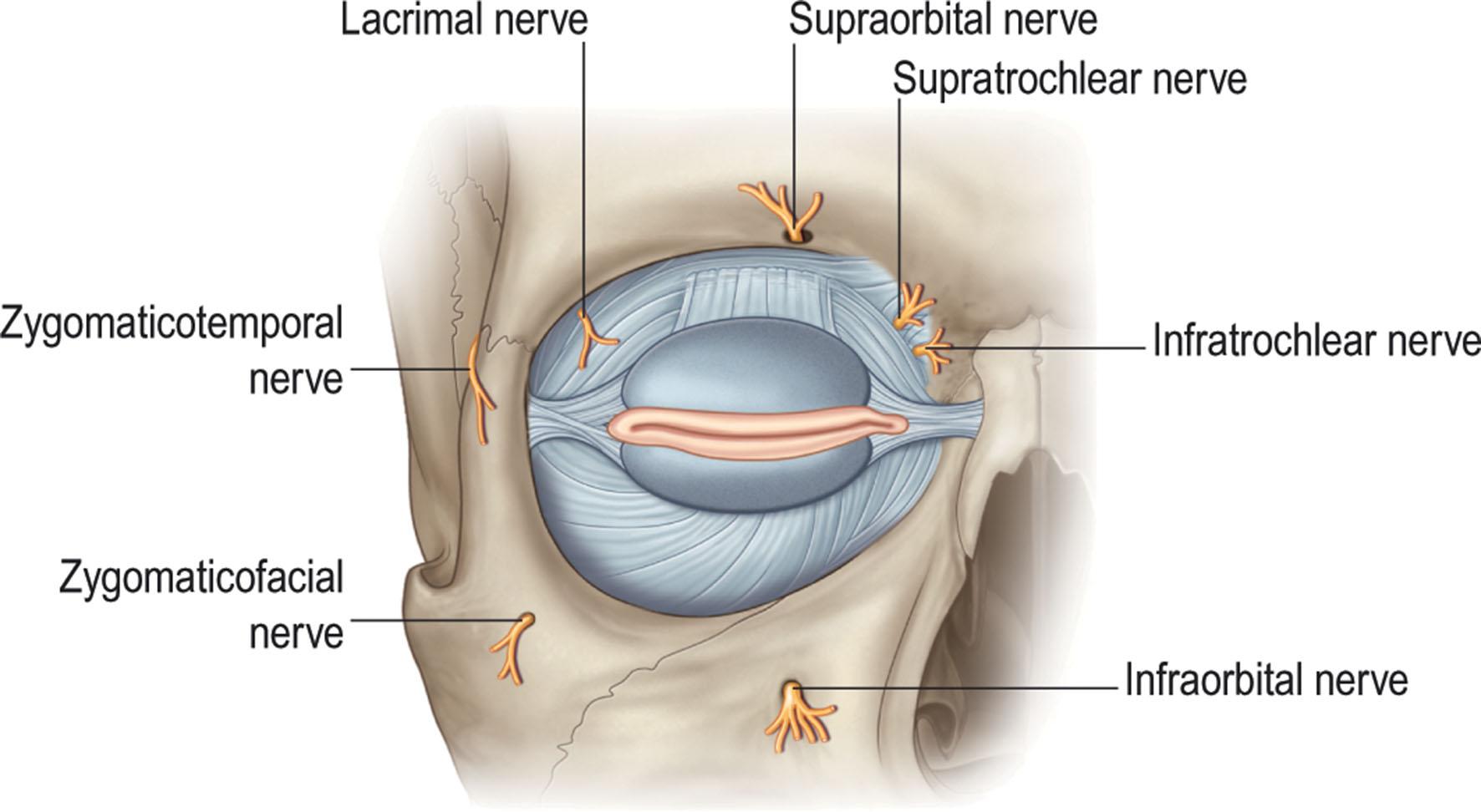
The maxillary division exits the orbit through one to three infraorbital foramina. It provides sensation to the skin of the nose, the lower eyelids, and the upper lid. Dissection is necessary lateral to the infraorbital nerve for successful midfacelifting and around the nerve for placement of tear trough implants.
The facial nerve exits the stylomastoid foramen and divides in the substance of the parotid gland into the superior temporofacial and inferior cervicofacial branches ( Fig. 13.16 ). The temporofacial nerve divides into the frontal, zygomatic, and buccal nerves; the cervicofacial nerve divides into the buccal, mandibular, and cervical nerves. There are significant variations in the branching of the facial nerve, which is responsible for facial expression. Innervation of facial muscles occurs on their deep surfaces. Interruption of the branches to the orbicularis muscle from periorbital surgery or facial surgery may result in atonicity due to partial denervation of the orbicularis with loss of lid tone or anomalous reinnervation and possibly undesirable eyelid twitching.
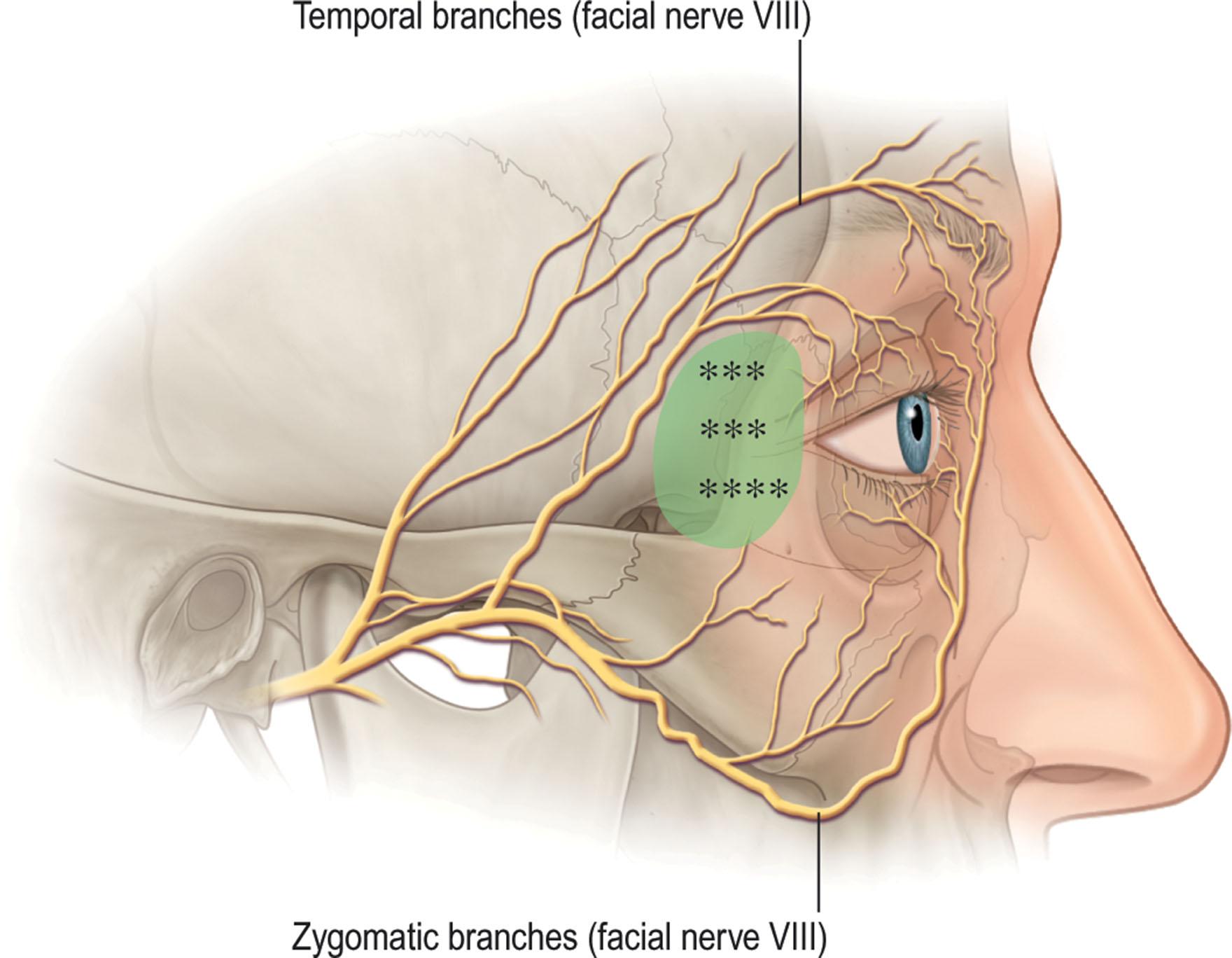
The frontal branch of the facial nerve courses immediately above and attached to the periosteum of the zygomatic bone. It then courses medially approximately 2 cm above the superior orbital rim to innervate the frontalis, corrugators, and procerus muscles from their deep surface. A separate branch travels along the inferior border of the zygoma to innervate the inferior component of orbicularis oculi. The surgeon should take great care when operating in this area to avoid damaging this nerve during endoscopic and open browlifts.
The characteristics of youthful, beautiful eyes differ from one population to another but generalizations are possible and provide a needed reference to judge the success of various surgical maneuvers. Attractive, youthful eyes are bright eyes. Bright eyes have globes framed in generously sized horizontal apertures (from medial and lateral), often accentuated by a slight upward tilt of the intercanthal axis ( Fig. 13.17 ). The aperture length should span most of the distance between the orbital rims. In a relaxed forward gaze, the vertical height of the aperture should expose at least three-quarters of the cornea with the upper lid extending down at least 1.5 mm below the upper limbus (the upper margin of the cornea) but no more than 3 mm. The lower lid ideally covers 0.5 mm of the lower limbus but no more than 1.5 mm.
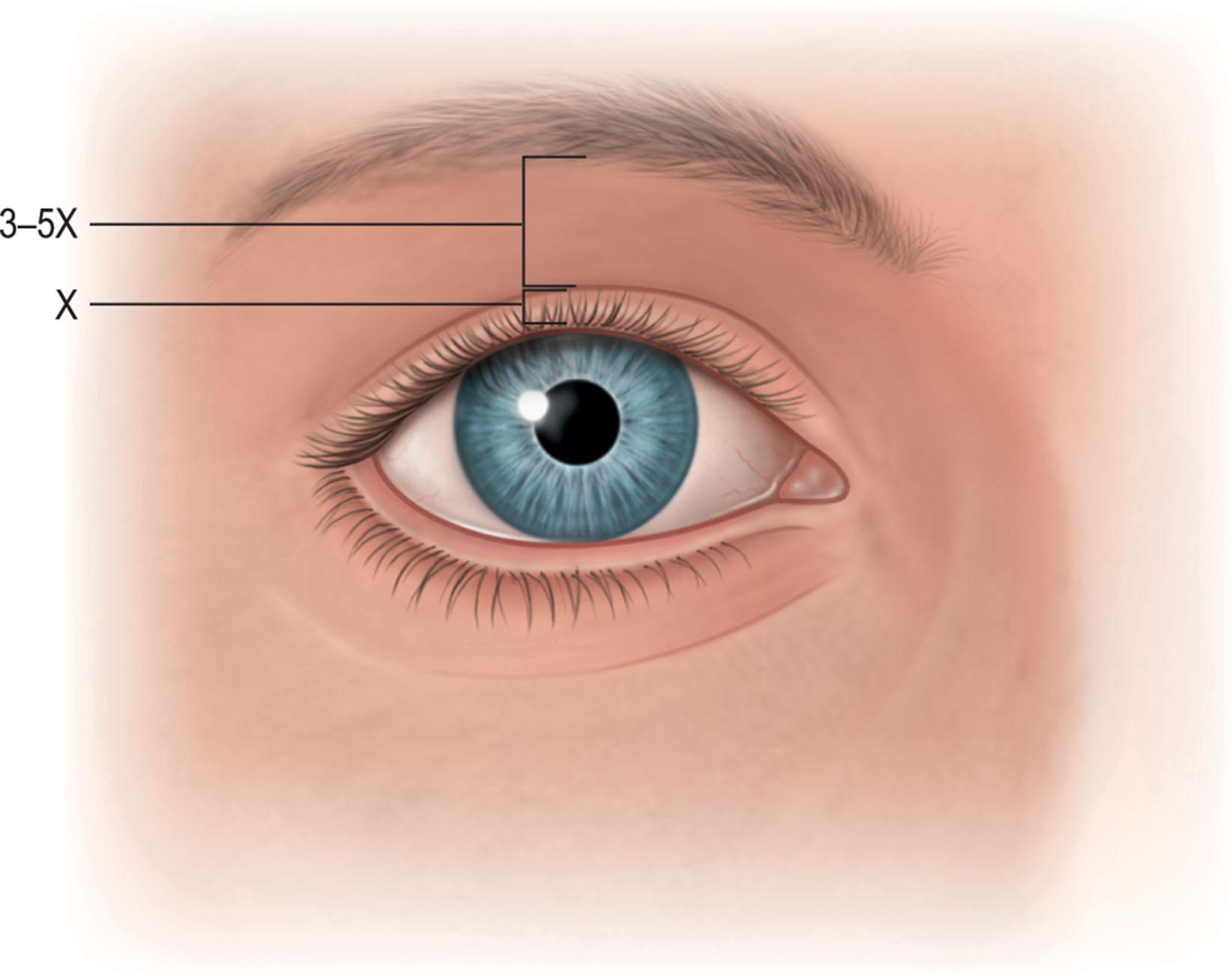
In the upper lid, there should be a well-defined lid crease lying above the lid margin with lid skin under slight stretch, slightly wider laterally. Ideally, the actual pretarsal skin visualized on relaxed forward gaze ranges from 3 to 6 mm in European ethnicities. The Asian lid crease is generally 2–3 mm lower, with the distance from lid margin diminishing as the crease moves toward the inner canthus. Patients of Indo-European and African descent show 1–2 mm lower than European ethnicities. The ratio of distance from the lower edge of the eyebrow (at the center of the globe) to the open lid margin to the visualized pretarsal skin should never be less than 3 : 1 (see Fig. 13.1 ), preferably more.
Scleral show is the appearance of white sclera below the lower border of the cornea and above the lower eyelid margin. In general, scleral show is contradictory to optimal aesthetics and may be perceived as a sign of aging, previous blepharoplasty, or orbital disease (e.g., thyroid disease). More than 0.5 mm of scleral show beneath the cornea on direct forward gaze begins to confer a sad or melancholy aura to one's appearance. However, in some youthful persons, the largeness of these apertures gives dramatic emphasis to the eyes and may be considered a strong and positive feature.
The intercanthal axis is normally tilted slightly upward (from medial to lateral) in most populations. Exaggerated tilts are encountered in some Asian, Indo-European and African-American populations. Such upward tilt of the lateral canthal axis may give the eye a youthful appearance, which is aesthetically pleasing in any ethnic group. The lower lid that droops in its lateral aspect and the eye with a downward tilt generally convey to the viewer an aging, ill-health distortion, or unattractiveness.
In the upper lid, excessive skin due to loss of elasticity and sun damage is one of the major causes of an aged appearance in the periorbital area. If there is an excess of skin that hangs over the lid or the upper eyelid appears to have multiple folds, it is difficult to have a rejuvenated appearance with cosmetics alone. In addition to relaxed skin changes, excessive fat herniation can cause bulging, resulting in a heavy appearance to the upper lid area. Although this fat is normal orbital fat, it appears to be protruding outward because of the laxity of the orbital septum, which holds the fat in place. Theoretically, replacement of the fat into a position that maintains a normal level of fat in the orbital area seems an optimal solution. However, this is not easily accomplished and may result in complications that are difficult to correct. Therefore, the skin and fat that seem to be in apparent excess should be treated accordingly.
The etiology of aging changes in the lower lids is similar in some ways but quite different in others. Aging changes include relaxation of the tarsal margin with scleral show, rhytides of the lower lid, herniated fat pads resulting in bulging in one or all of the three fat pocket areas, and hollowing of the nasojugal groove and lateral orbital rim areas. Hollowing of the nasojugal groove area appears as dark circles under the eyes, mostly because of lighting and the shadowing that results from this defect ( Fig. 13.18 ). It is clear that evaluation of all aspects of aging changes in the lids is important so the surgeon can plan the most effective operative procedure.
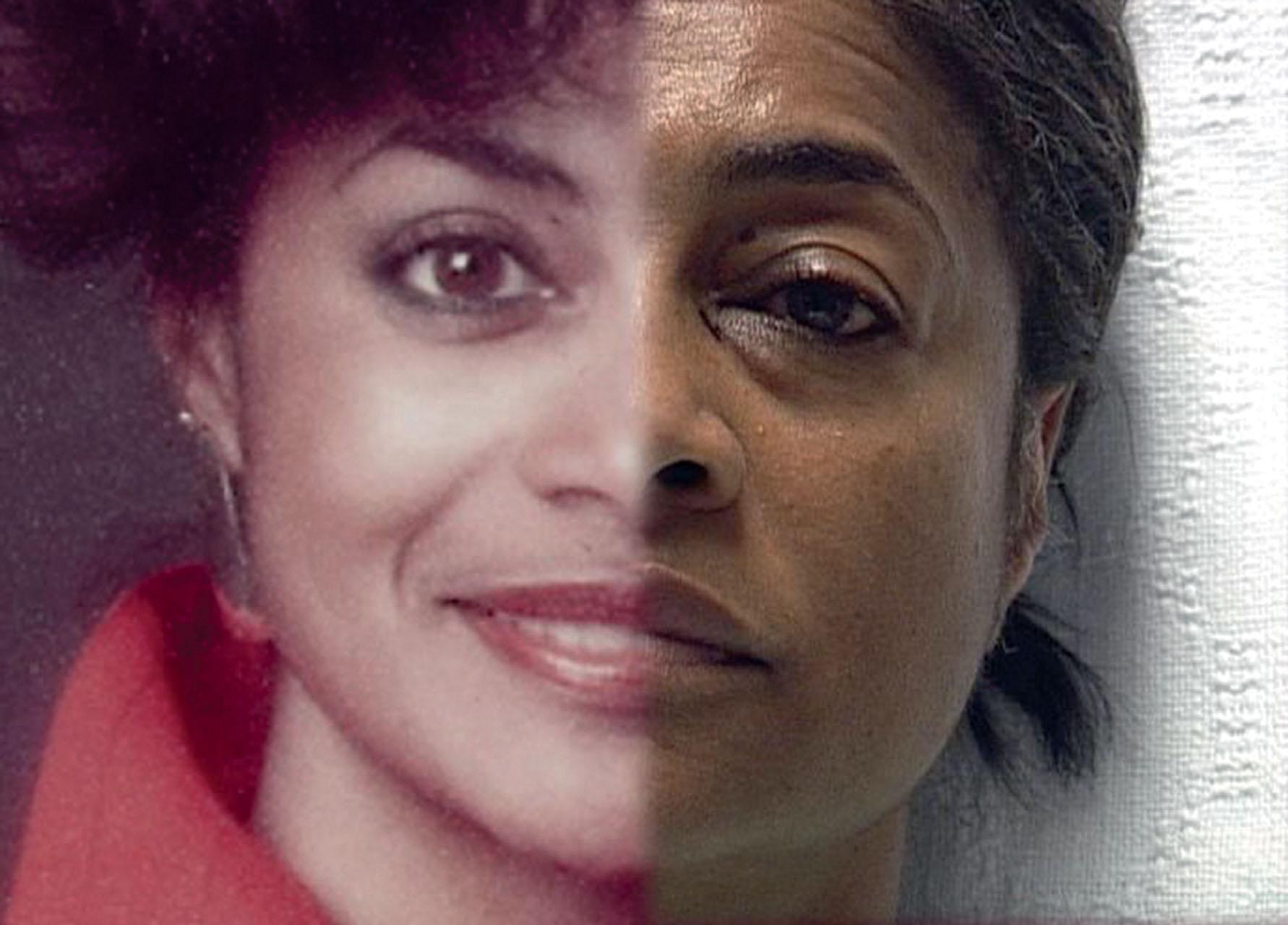
The first essential step is to look at the patient carefully, thoroughly, and critically. The surgeon should be seated directly in front of the prospective patient with the patient's eyes at his or her eye level. Note the general impression and feeling generated from looking at this person ( Fig. 13.19 ).
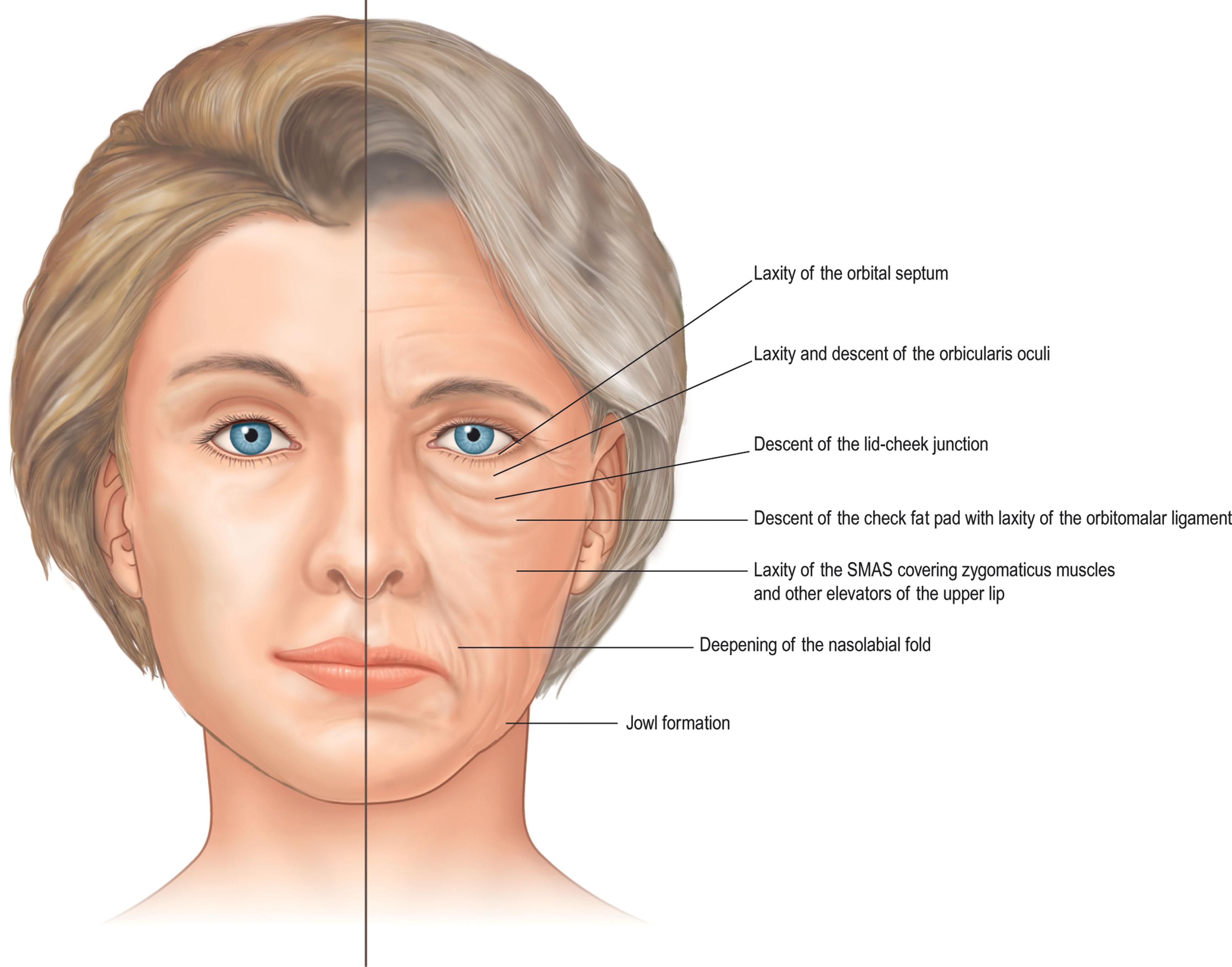
One should also look for areas of symmetry or asymmetry. Notice the shape of the eye; the prominence or asymmetry of the globes; and evidence of exposure, dryness, or injection of vessels. Look for evidence of decreased tone and dropped posture of the lower lids. What is the posture of the upper lid? Are the upper lids symmetric? Is there lid ptosis? At what level does the upper lid traverse the globe? What levels do the upper and lower lids sit in relation to the limbus?
Next, have the patient relax the brow and close the eyes. Do the lids close? Then ask the patient to open the eyes. Is it necessary to raise the brows to effect comfortable forward vision? Does the corrugator frown increase in prominence with the eyes closed and the forehead relaxed? Is there transverse brow wrinkling? Is one brow lower? Which one and how much? Is there a prominent frown?
Assess the lower lid tone by pulling the lid away from the globe and releasing, making sure the patient does not blink (modified snap test). Does each lid spring back immediately, reluctantly, or not at all? Is it held against the globe by only the tear seal? Most people presenting for blepharoplasty have a significant decrease in their lower lid tone, often asymmetric.
What, if anything, would improve the aesthetic appearance of the eyes and periorbital region? Are there festoons or deep grooves (i.e., nasojugal grooves or tear trough deformities)? Is there excess skin, muscle, or fat? Quantitate any excess soft tissue on a simple eye diagram. Does restoration of lateral canthal posture correct the illusion of excess skin on the lower eyelid? Does it diminish it? Does the orbital septum appear to be excessively relaxed? Note the tilt of the intercanthal axis or lack thereof.
The “four-finger lift” is performed by encircling the outer orbit with the tips of the index, middle, ring, and little fingers on one hand. With the index and middle fingers above the lateral brow, place the ring finger lateral to the canthus and little finger beneath the lateral canthus just lateral to the malar prominence. Gently move the four fingers posteriorly and superiorly to lift the lateral brow, canthus, and cheek. If this test restores youthfulness and attractiveness, a canthopexy, browlift, and midfacelift may be beneficial.
A thorough history and physical examination should be performed before surgery ( Box 13.2 ). In addition, an adequate eye history encourages positive outcomes and reduces eye complications.
Medication use: particularly anticoagulants, anti-inflammatory and cardiovascular drugs, and vitamins (especially vitamin E).
Herbal supplement use: herbs represent risks to anesthesia and surgery, particularly those affecting blood pressure, blood coagulation, the cardiovascular system, and healing.
Allergies: medication and type.
Past medical history: especially hypertension, diabetes, cardiovascular and cerebrovascular disease, hepatitis, liver disease, heart disease or arrhythmias, cancer, thyroid disease, and endocrine disease.
Bleeding disorders or blood clots.
Psychiatric disease.
Alcohol and smoking history.
Recreational drug use, which may interact with anesthesia.
Exposure to human immunodeficiency virus and hepatitis virus.
Any history of facial herpes zoster or simplex.
Contact lens wear poses particular risks when eyelid surgery is performed. The natural progression of aging dries the eyes out, and long-term contact lens wearing hastens this process considerably. Traditional blepharoplasty techniques consistently produce vertical dystopia with increased scleral exposure, making the lens wear difficult if not dangerous. Ptosis and canthopexy surgery may alter the corneal curvature and require that contacts be refitted. The patient should discontinue contact lens wear in the perioperative period to allow healing without the need to manipulate the eyelids. Levator dehiscence or attenuation commonly accompanies long-term hard contact lens wear, caused by the mechanical stresses posteriorly from the rigid lens rubbing against the posterior lamella of the lid.
The same population that seeks aesthetic surgery also gravitates toward refractive surgery, such as LASIK (laser-assisted in situ keratomileusis). A history of such surgery is necessary information because periorbital surgery, particularly canthopexies and levator surgery, can affect the refractive characteristics, cause mechanical irritation of the conjunctiva and cornea, or affect the corneal flap. Ptosis repair or debulking of heavy upper lids can change the corneal curvature, resulting in the need for a new prescription for eyeglasses. Canthopexy normally raises the contact point of the lid with the globe and can increase the tension of the lid with the globe and can increase the tension of the lid against the cornea, affecting corneal curvature. It can cause conjunctival chemosis or produce corneal erosion early postoperatively. Dry eye exposure problems are most prevalent in patients who have undergone LASIK surgery because the flap disrupts corneal innervations, forming an anesthetic effect that suppresses tear production. When in doubt, such patients should be reviewed by their refractive surgeon before undergoing blepharoplasty.
One should check for a history of other eye procedures, including glaucoma surgery (forms a bleb of conjunctival tissue on the superior limbus), retinal, strabismus, and cataract surgery. Evaluate carefully for a history as well as physical evidence of facial muscle weakness, extraocular muscle imbalance, Bell palsy, or trauma, in addition to orbicularis hyperactivity such as blepharospasm or hemifacial spasm. Any ocular condition may affect the type or result of eyelid surgery.
Superior or lateral visual field loss suggests functional ptosis or pseudoptosis. A 12–20° or a 30% improvement of the superior visual field, between a taped and untaped upper lid, may qualify for medical necessity.
Chronic eye irritation, such as tearing, dryness, excessive blinking, discharge, eyelid margin inflammation, crusting, burning, or itching, must be brought under control before any surgery. Dry eyes should be aggressively sought out and treated before surgery.
Dry irritated eyes before surgery will lead to irritated eyes after surgery, and the surgeon may be blamed. On questioning, most patients will rarely admit to dry eyes, although it is known that the eyes dry out considerably throughout our lifetime. Treatment options include artificial tears, ointment, anti-inflammatory drops, and punctal plugs or punctal closure.
Exophthalmos, unilaterally or bilaterally, associated with a thyroid disorder should be completely stabilized for approximately 6 months before elective aesthetic surgery. However, there may be an urgent requirement in active Graves' disease to perform procedures to protect the globe or the vision.
Become a Clinical Tree membership for Full access and enjoy Unlimited articles
If you are a member. Log in here